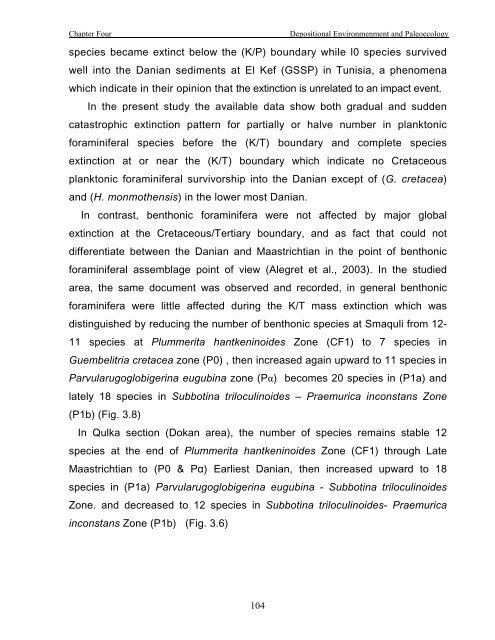biostratigraphy and paleoecology of cretaceous/tertiary boundary in ...
biostratigraphy and paleoecology of cretaceous/tertiary boundary in ...
biostratigraphy and paleoecology of cretaceous/tertiary boundary in ...
You also want an ePaper? Increase the reach of your titles
YUMPU automatically turns print PDFs into web optimized ePapers that Google loves.
Chapter Four<br />
Depositional Environmenment <strong>and</strong> Paleoecology<br />
species became ext<strong>in</strong>ct below the (K/P) <strong>boundary</strong> while l0 species survived<br />
well <strong>in</strong>to the Danian sediments at El Kef (GSSP) <strong>in</strong> Tunisia, a phenomena<br />
which <strong>in</strong>dicate <strong>in</strong> their op<strong>in</strong>ion that the ext<strong>in</strong>ction is unrelated to an impact event.<br />
In the present study the available data show both gradual <strong>and</strong> sudden<br />
catastrophic ext<strong>in</strong>ction pattern for partially or halve number <strong>in</strong> planktonic<br />
foram<strong>in</strong>iferal species before the (K/T) <strong>boundary</strong> <strong>and</strong> complete species<br />
ext<strong>in</strong>ction at or near the (K/T) <strong>boundary</strong> which <strong>in</strong>dicate no Cretaceous<br />
planktonic foram<strong>in</strong>iferal survivorship <strong>in</strong>to the Danian except <strong>of</strong> (G. cretacea)<br />
<strong>and</strong> (H. monmothensis) <strong>in</strong> the lower most Danian.<br />
In contrast, benthonic foram<strong>in</strong>ifera were not affected by major global<br />
ext<strong>in</strong>ction at the Cretaceous/Tertiary <strong>boundary</strong>, <strong>and</strong> as fact that could not<br />
differentiate between the Danian <strong>and</strong> Maastrichtian <strong>in</strong> the po<strong>in</strong>t <strong>of</strong> benthonic<br />
foram<strong>in</strong>iferal assemblage po<strong>in</strong>t <strong>of</strong> view (Alegret et al., 2003). In the studied<br />
area, the same document was observed <strong>and</strong> recorded, <strong>in</strong> general benthonic<br />
foram<strong>in</strong>ifera were little affected dur<strong>in</strong>g the K/T mass ext<strong>in</strong>ction which was<br />
dist<strong>in</strong>guished by reduc<strong>in</strong>g the number <strong>of</strong> benthonic species at Smaquli from 12-<br />
11 species at Plummerita hantken<strong>in</strong>oides Zone (CF1) to 7 species <strong>in</strong><br />
Guembelitria cretacea zone (P0) , then <strong>in</strong>creased aga<strong>in</strong> upward to 11 species <strong>in</strong><br />
Parvularugoglobiger<strong>in</strong>a eugub<strong>in</strong>a zone (Pá) becomes 20 species <strong>in</strong> (P1a) <strong>and</strong><br />
lately 18 species <strong>in</strong> Subbot<strong>in</strong>a trilocul<strong>in</strong>oides – Praemurica <strong>in</strong>constans Zone<br />
(P1b) (Fig. 3.8)<br />
In Qulka section (Dokan area), the number <strong>of</strong> species rema<strong>in</strong>s stable 12<br />
species at the end <strong>of</strong> Plummerita hantken<strong>in</strong>oides Zone (CF1) through Late<br />
Maastrichtian to (P0 & Pá) Earliest Danian, then <strong>in</strong>creased upward to 18<br />
species <strong>in</strong> (P1a) Parvularugoglobiger<strong>in</strong>a eugub<strong>in</strong>a - Subbot<strong>in</strong>a trilocul<strong>in</strong>oides<br />
Zone. <strong>and</strong> decreased to 12 species <strong>in</strong> Subbot<strong>in</strong>a trilocul<strong>in</strong>oides- Praemurica<br />
<strong>in</strong>constans Zone (P1b) (Fig. 3.6)<br />
104

















